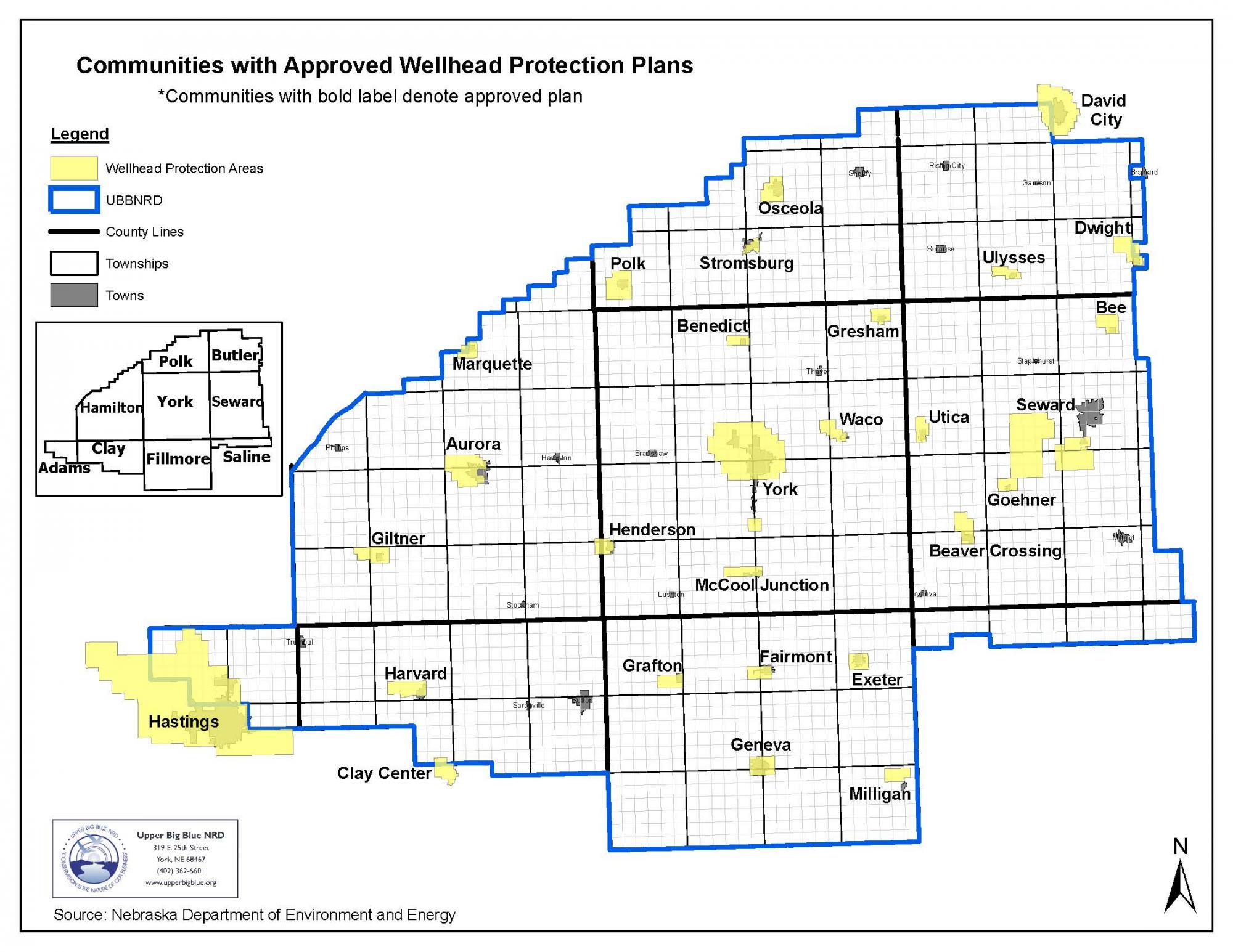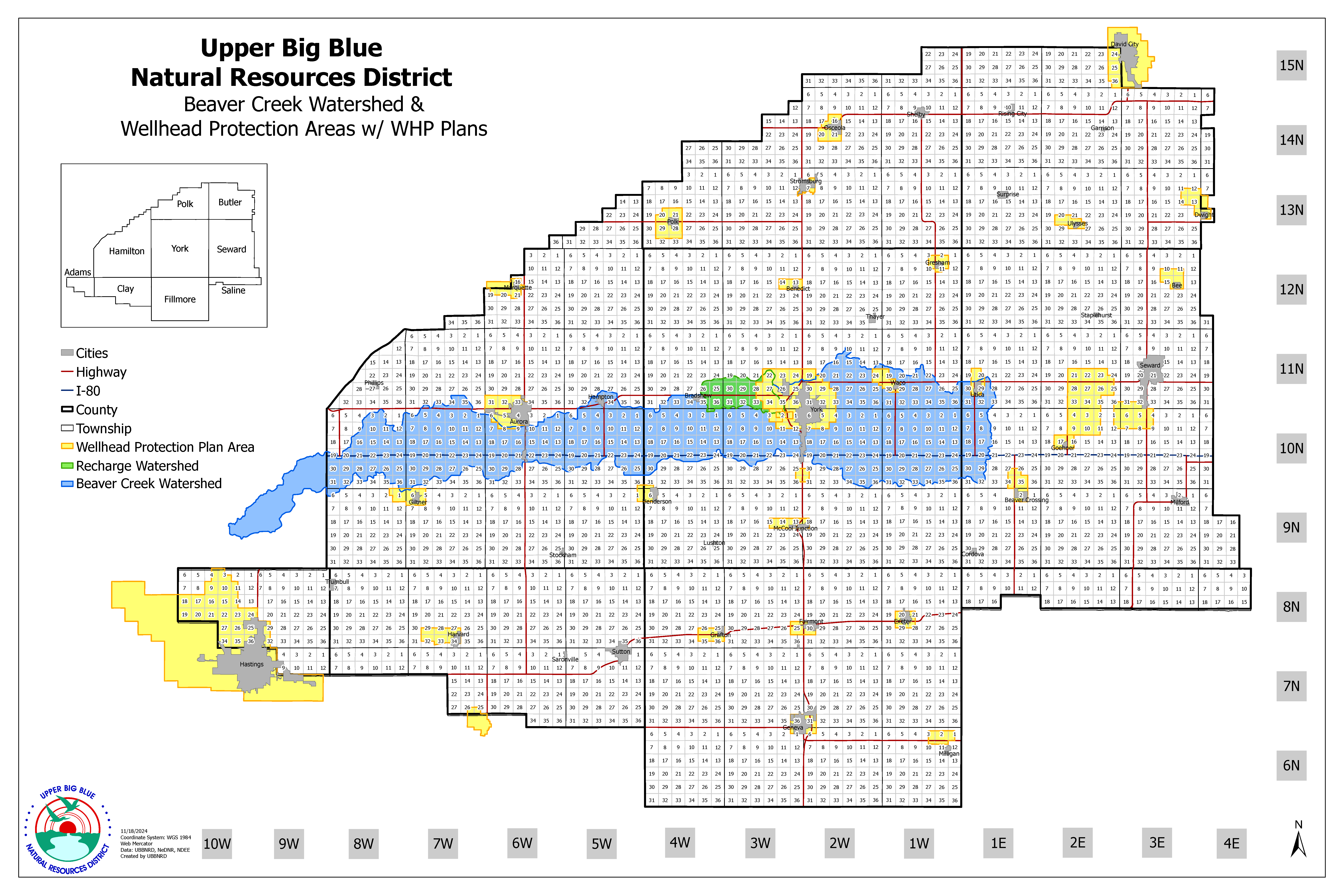WQMP Incentive Program
The Upper Big Blue Natural Resources District is offering an incentive program for producers in portions of the Recharge Lake Watershed, Beaver Creek Watershed, and qualifying municipal Wellhead Protection Areas. Practices included are cover crops, land treatment practices, and buffer/filter strips.
To get started, please complete this short form or call the office at (402) 362-6601 with any questions you might have. The application process is quick and easy to allow for the installation of conservation practices without delay. This program is funded directly by the Upper Big Blue Natural Resources District and is not affiliated with any federal conservation programs. However, the program does include collaboration with local NRCS soil specialists to ensure the best results.
Cover Crops
The Upper Big Blue Natural Resources District is looking for landowners, or operators, in the Beaver Creek Watershed and qualifying Municipal Wellhead Protection Areas willing to plant cover crop seed on their row crop acres. Cover crops are proven to:
- Reduce erosion from wind and water
- Increase soil organic matter content
- Capture and recycle or redistribute nutrients in the soil profile
- Promote biological nitrogen fixation and reduce energy use
- Increase biodiversity
- Suppress weeds
- Manage soil moisture
- Minimize and reduce soil compaction
- Improve yields by enhancing soil health
- Reduce use of herbicides and pesticides
- Create grazing opportunities
Funding Availability
An estimated $100,000 will be available beginning in the fall of 2025 (Actual funding available will depend on annual NRD Budgets). For approved applications, the cost-share rate will be up to $75.00/acre for all costs (seed, planting, terminating) up to a maximum of $7,500 per landowner per year. Applications are approved for a one-year term. NRCS and/or other federal, state, or local government program cost share funds may not be combined with this program. All seed selection and seeding must abide by NRCS Code 340 Cover Crop Criteria and Scenarios (see Attachment 3).
Eligibility
- Lands located in the Upper Big Blue NRD within the Beaver Creek Watershed.
- Lands located within a qualified Municipal Well Head Protection Area (must have an approved Well Head Protection Plan) within the Upper Big Blue NRD.
- Landowners and Operators are eligible for this program.
- If approval is given to a Tenant, the District will notify the Landowner by mail that the practice was approved for planting.
Priority Areas
- Beaver Creek Watershed
Tracts located in the Beaver Creek Watershed are eligible. Tracts located in the “Riparian Critical Zone”, the “Very High Runoff Risk” and the ”High Runoff Risk” categories, as designated by the Agricultural Conservation Planning Framework (ACPF), are given a higher priority. (The ACPF identifies locations where specific landscape attributes are favorable for implementing certain conservation practices and prioritizes these locations according to their susceptibility to runoff and erosion). - Municipal Wellhead Protection Areas
Tracts located in a Municipal Wellhead Protection Area where the municipality has an approved Wellhead Protection Area Plan are eligible.
The NRD will rank applications on a priority based on:
- Riparian Critical Zones of the Beaver Creek Watershed (Attachment 1)
- Very High Runoff Risk Category Areas of the Beaver Creek Watershed (Attachment 1)
- High Runoff Risk Category Areas of the Beaver Creek Watershed (Attachment 1)
- Areas located in a qualified Municipal Wellhead Protection Area (with approved Wellhead Protection Plans) (Attachment 2)
- Areas located in the Beaver Creek Watershed (Attachment 1)
- First year applicants will be given a priority within the above areas.
Riparian critical zones occur in areas where high runoff and shallow water tables intersect within a stream corridor. These critical zones have the greatest chance of anywhere along the length of a stream to deliver pollutants directly into the water system.
Critical Source Areas (CSAs) are relatively small fractions of a watershed that generate a disproportionate amount of the pollutant load. An assessment provides a risk rating based on slope steepness and the distance to a stream. Through this assessment, areas are assigned a risk ratings of Very High Risk, High Risk, Moderate Risk, Low Risk, or unknown risk.
A Wellhead Protection Area is defined as the surface and subsurface area surrounding a public water well or wellfield, through which contaminants are reasonably likely to move toward and reach such water well or wellfield.
Application Process
Applications are due to the NRD by close of business on July 18, 2025.
The NRD will rank applications, and notify approved applicants by August 15, 2025 with their authorization number.
Selected applicants must submit an Upper Big Blue NRD – WQMP Cover Crop Program Application, a United States Citizenship Attestation Form, and a W-9 Request for Taxpayer Identification Number and Certification Form (NRCS will assist in filling out the correct forms).
Upon receipt of all the necessary forms, the NRD will assign the applicant an authorization number. Cover crop program activities and purchases must not begin prior to authorization. Purchases of seed and/or services made prior to the authorization are not eligible for funding.
Late Applications
Applications submitted following the due date (July 18, 2025) may be considered if program funding is available.
Cost-Share Rate
The landowner/operator will receive $75.00 per acre up to a maximum of $7,500.00 per landowner/operator per year.
Contracts
- This Program is limited to one contract per landowner/operator.
- Landowners/operators may re-apply following completion of the first year contract, but first time participants will be given priority.
Payment
After the landowner/operator plants the cover crop, the NRCS will verify that the cover crop meets NRCS requirements.
The Landowner/Operator must turn in any receipts for the cover crops to the NRCS.
NOTE: Cover crop program activities and purchases must not begin prior to authorization. Any purchases of seed and/or services made prior to authorization are not eligible for funding.
The NRCS will verify completion of the cover crop and will notify the NRD for final payment.
Other Program Notes
NRCS and/or other federal, state, or local government funds may not be combined with this program.
Seed selection and planting rates must abide by the NRCS Code 340 Cover Crop for planting rate, planting date, and termination. Seeding may be completed by drilling, aerial, or broadcast application (see Attachment 3).
Selected WQMP Cover Crop Program applicants will not be eligible to participate in the WQMP Land Treatment Incentive Program. These applicants may participate in the NRD’s regular Land Treatment Program.
Future year program contracts will be based on funding allocated in future years budgets. Landowners/operators may apply each year but first time participants will be given priority.
Available program funding will depend on annual NRD Budgets.
Buffer Strips
The Nebraska Buffer Strip Program offers financial assistance for landowners that install filter strips (narrow strips of grass) or riparian forest buffer strips (strips containing trees and grass).
These strips are placed next to seasonal or permanent streams, wetlands, and ponds. These practices provide protection between cropland and waterbodies by helping to stabilize the environment and filter agrichemicals such as fertilizers and pesticides.
Contracts run from 5 to 10 years. State program payments vary from $20 to $250 per acre, depending on soil type, whether the acres are irrigated or not, and whether payments are received from other programs. In addition, there are incidental haying and grazing allowances through the program.
The Upper Big Blue Natural Resources District (UBBNRD) completed a Water Quality Management Plan (WQMP) and selected the Recharge Lake Watershed and the Beaver Creek Watershed as the initial target areas for implementing water quality measures.
Through the UBBNRD’s WQMP Implementation Program, the UBBNRD is offering an additional incentive payment for filter and buffer strips within the Recharge Lake Watershed and the Beaver Creek Watershed.
Applications
Applicants will apply through the Natural Resources Conservation Service (NRCS) under the Nebraska Buffer Strip Program.
Eligibility
- Only landowners are eligible for the Nebraska Buffer Strip Program.
- Lands located within the Recharge Lake watershed and/or the Beaver Creek watershed are eligible for the UBBNRD incentive program. (Attachment 1)
- Landowner must meet all requirements and be approved under the Nebraska Buffer Strip Program.
- Only new or renewed buffer strip projects are eligible for the incentive program.
Payment
In addition to the Nebraska Buffer Strip Program payment, the landowner will receive an UBBNRD incentive payment set at 50% of the Nebraska Buffer Strip Program payment for the life of the contract (5 to 10 years).
If the buffer strip is removed before the expiration of the contract, the landowner must return all previous incentive payments to the NRD.
Land Treatment
The Upper Big Blue Natural Resources District’s (NRD) Land Treatment Program provides technical and financial assistance for soil and water conservation projects. These practices prevent or reduce soil erosion, sedimentation, and water contamination, and assist with management of both surface water and groundwater. Many also provide wildlife habitat benefits. Eligible practices include terraces, water impoundment dams, grade stabilization structures, diversions, grassed waterways, sediment control basins, pasture planting, windbreak planting and windbreak renovation, planned grazing systems, stream bank stabilization, and brush management. The program offers 75% cost share for these practices with a maximum of $10,000 per landowner per year. These practices have a design life of 10 – 20 years. Funding for the Land Treatment Program is from the Nebraska Soil and Water Conservation Program and from NRD funds.
The NRD recently completed a Water Quality Management Plan (WQMP) which serves as a roadmap to improve the water resources and water quality within the NRD. District-wide and targeted implementation efforts to address sediment, nutrients, bacteria, and atrazine will be accomplished through existing programs. The Beaver Creek Watershed was selected as the initial target area for implementing water quality measures.
Through the NRD’s WQMP Incentive Program, the NRD is offering an additional incentive payment for land treatment practices within the riparian critical zone and the very high runoff risk and high runoff risk areas of the Beaver Creek Watershed. Under this WQMP incentive program, practices within these very high runoff risk and high runoff risk areas will be cost-shared at 90% with a maximum of $15,000 per landowner per year.
Applications
Applicants will apply through the Natural Resources Conservation Service (NRCS) under the NRD’s WQMP Land Treatment Implementation Incentive Program.
Eligibility
Only landowners are eligible for the WQMP Land Treatment Incentive Program.
Lands located in the Upper Big Blue NRD within the “Riparian Critical Zones” and “Very High Runoff Risk” and ‘High Runoff Risk” of the Beaver Creek Watershed, as designated by the Agricultural Conservation Planning Framework (ACPF), categories are eligible. The ACPF identifies locations where specific landscape attributes are favorable for implementing certain conservation practices and prioritizes these locations according to their susceptibility to runoff and erosion.
Landowners must meet all requirements and be approved under the NRCS practice standards.
Landowners participating in the NRD’s WQMP Cover Crop Program are not eligible to participate in the WQMP Land Treatment Incentive Program. These landowners may participate in the Land Treatment Program without the increased incentive.
Payment
Practices approved through this program will receive 90% of the NRCS Environmental Quality Incentives Program (EQIP) Rate or 90% of the actual costs, whichever is less, up to a maximum of $15,000.00.
If the practice removed before the expiration of the design life of the practice, the landowner must return all previous incentive payments to the NRD.




